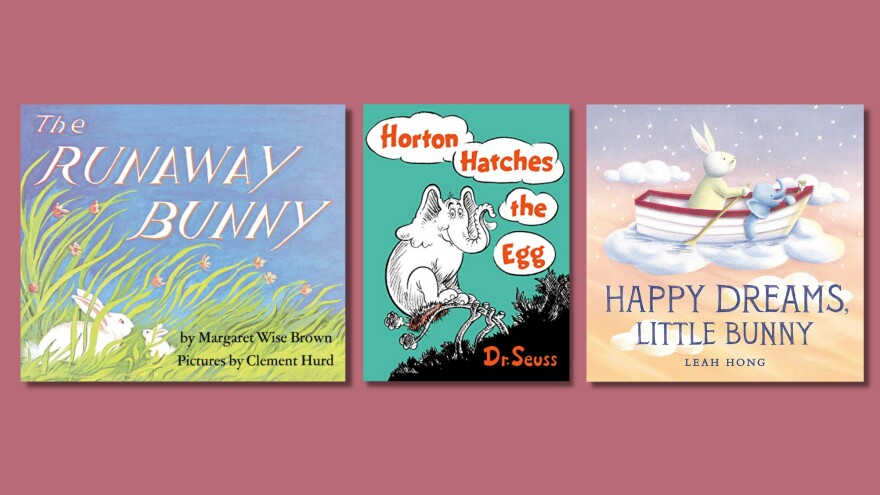We bring our own, individual experiences, beliefs and aspirations to the stories we read. A parent might think Runaway Bunny is about a mother's unconditional love and protection. A child might think, "Will she ever leave me alone?"
This Mother's Day we asked a handful of children's book experts and writers which stories and characters come to mind when they think about motherhood. We didn't say they had to like the depictions. But we also asked for their recommendations.
Our contributors:
NoNieqa Ramos is an educator and writer of picture books and young adult literature including the 2021 Kirkus Best Picture Book Your Mama, illustrated by Jacqueline Alcántara. They found the mom in Love You Forever "muy muy creepy."
Claudia Pearson is a retired trial lawyer and graduate of Hollins University's Masters in Children's Literature program and author of Have a Carrot: Oedipal Theory and Symbolism in Margaret Wise Brown's Runaway Bunny Trilogy. She's got issues with Horton Hatches The Egg.
Rebecca Steinitz is a writer and book reviewer whose work has appeared in The Boston Globe, The Huffington Post, Washington Post, and New Republic. She's a proponent of mom characters who aren't "always trying to fix everything."
Cozbi A. Cabrera is the author and illustrator of the Caldecott and Coretta Scott King Honor Book Me & Mama. She says the mom in her story "knows that a child is not an appendage of yourself."
Runaway Bunny by Margaret Wise Brown

No matter how this little bunny imagines running away, his mom will be right behind him, even if that means turning into a fisherman, tightrope walker or the wind. Since it was first published in 1942, Brown's Runaway Bunny has never gone out of print. "I like to call her a stalker mother," says Rebecca Steinitz, "I mean, this child just wants to go out on their own and their mother follows them everywhere they go." Steinitz adds that, yes, "We want our children to stay with us forever and be right in our laps. But we know as healthy, balanced people that part of our job is to let our children go out and live their lives." Claudia Pearson agrees, though she also believes it's "pretty much a work of genius," because Brown opened the door "for parents to feel like they're reading a story about love and caring about their child while the child is exploring their own individual identity and how close they are or separated they are from the adults in their lives."
Happy Dreams, Little Bunny, written and illustrated by Leah Hong

When a Little Bunny's thoughts keep him from falling asleep, his mom encourages him to use his imagination "to turn his thoughts into dreams." NoNieqa Ramos recommends Happy Dreams, Little Bunny as "a next-generation Runaway Bunny sans the stalking mom." She says, "we still have the soft pillowy illustrations. But in her version, we have a mama who is a safe anchor nudging her little one from his anxieties into a sea of dreams. Through a gentle dialogue, she guides him to find respite in his imagination and to grow in autonomy and independence."
Bread and Jam for Frances written by Russell Hoban with pictures by Lillian Hoban

Frances only wants to eat bread and jam at every mealtime. Rather than force her to do otherwise, her parents give her what she thinks she wants. But after four meals of bread and jam, Frances admits she might like the spaghetti everyone else at the table is having. "Her parents enable her to follow all the way through on this mistake of saying the only thing worth eating is bread and jam," says Steinitz. "And then, as soon as she asked for the spaghetti, they give her the spaghetti and, problem solved by Frances. She solved it herself."
Love You Forever written by Robert Munsch, illustrated by Sheila McGraw

With hints of Runaway Bunny, the mother in Love You Forever plans to put her son to bed every night of his life, even into his adulthood and her old age. That includes driving to his house at night and using a ladder to climb up into his bedroom. "That is a twisted book," says Steinitz, though she admits she still recites the book's refrain, "I'll love you forever, I'll like you for always, As long as I'm living my baby you'll be." "Muy muy creepy," says Ramos. But, like a lot of moms who read this to their kids, Ramos says, "This book made my godmother weep sentimental tears as she shared it with me." Ramos adds that the hip mom she created for her book Your Mama "would not be crawling through yo' window."
Horton Hatches The Egg by Dr. Seuss

"Lazy" bird mom Mayzie, tired of sitting on her egg, decides she needs a Palm Springs vacation. She tricks Horton the elephant into doing it for her. Since Horton is, "faithful, one hundred per cent," he sits and sits, enduring bad weather, taunts and all kinds of other hardships. The Dr. Seuss bestseller has been analyzed through the lens of adoption and Christianity. Pearson takes issue with all the sitting as a description of "what it is a mother-to-be does while waiting on the birth of the child." While Dr. Seuss "may have been intending to give [mothers] kudos," says Pearson, "in the end he basically was maligning them through Mayzie the lazy bird, and only a man would do this because he would stay and do what needed to be done."
Brown Angels: An Album of Pictures and Verse by Walter Dean Myers

One of Cozbi A. Cabrera's favorite books for Mother's Day is the late Walter Dean Myers' Brown Angels, a collection of vintage photographs Myers collected over the years. Myers writes, "Seeing their faces scrubbed and beaming, seeing them dressed in their Sunday best," made him think about the "hardworking" parents and grandparents who took time and care to celebrate their children, "despite the difficulties of their own lives." Cabrera says, "He could see evidence of a level of care and consideration and also hope for what the future might bring for these incredible lives."
Mommy's Hometown by Hope Lim

This story about a boy and his mother's trip to her childhood home in Korea is a favorite new read for Ramos. The boy discovers the town is not how he imagined it would be. Ramos says when she describes her own upbringing in the Bronx, "I talk about parks, the ninety-nine field trips to the Bronx Zoo, etc. But when I brought my two suburban kids to the Bronx for my prima's wedding, they looked at me like I had two heads. They started choking and said they couldn't breathe, I kid you not. They smelled what I smelled, but did not see what I saw." Ramos says, "Mommy's Hometown starts from the specific lens of Korean culture, but has the universal motifs of memory and perception."
Maybe Days: A Book For Children in Foster Care by Jennifer Wilgocki, Marcia Kahn Wright, illustrated by Alissa Imre Geis

"Living in a foster home is usually not the kid's idea. It's also not the kid's fault," reads a page from Maybe Days. Pearson calls this "a very moving book" that "does a great job of explaining difficult things to children who are removed from their parents." Published in 2001 by the American Psychological Association, Pearson says, "That's one of the questions that children who are removed from their parents ask is 'When will I ever get to go live with my parents again?' And how much they hate all the 'maybes' in their lives."
Copyright 2022 NPR. To see more, visit https://www.npr.org.




